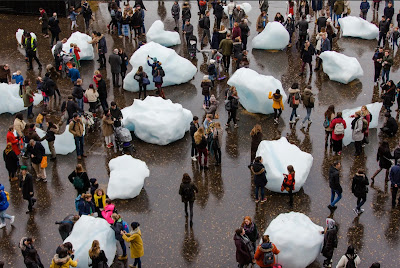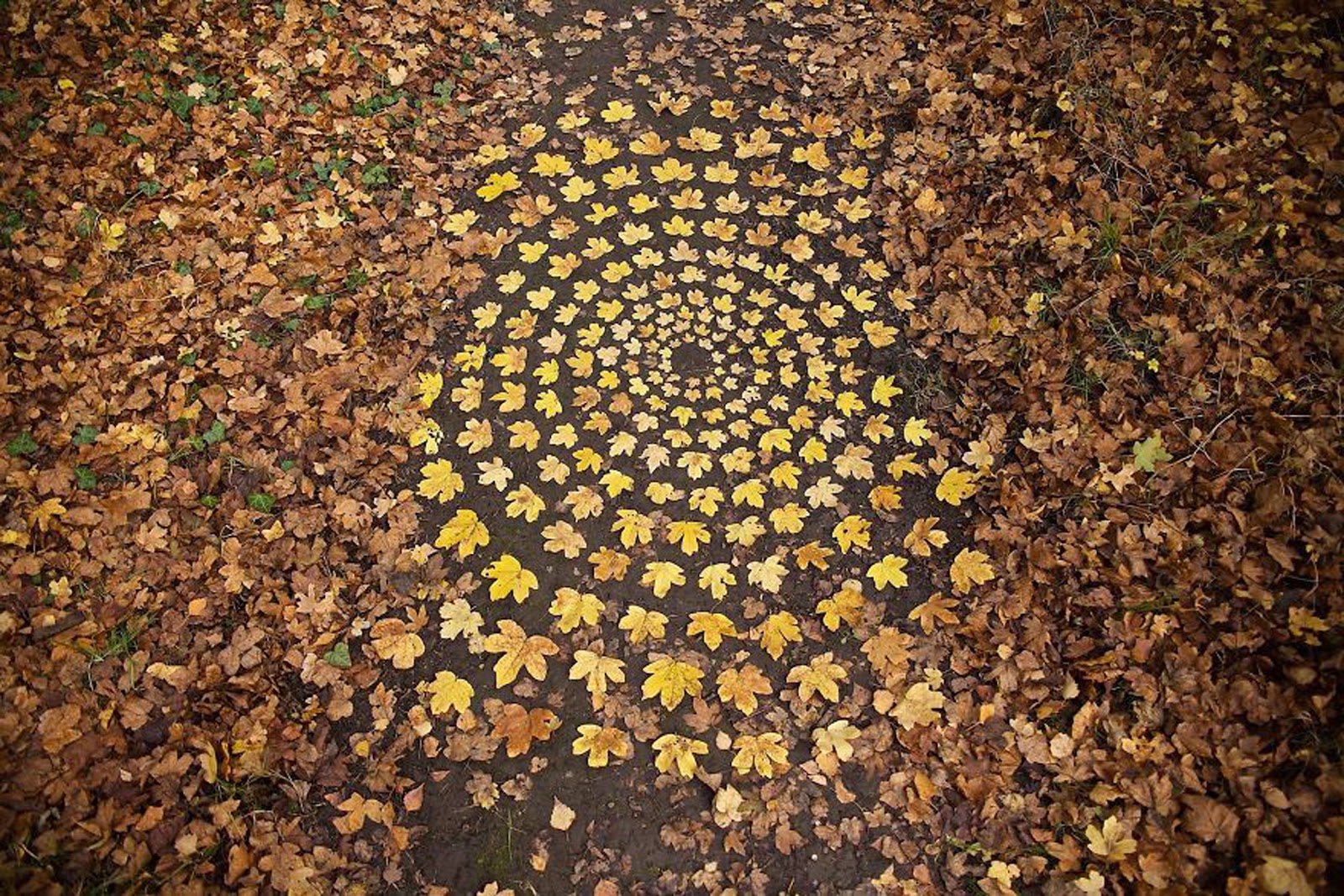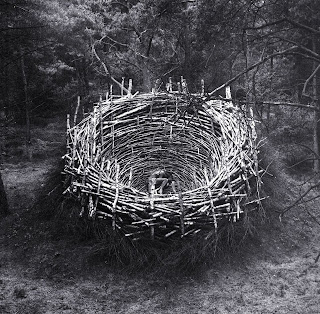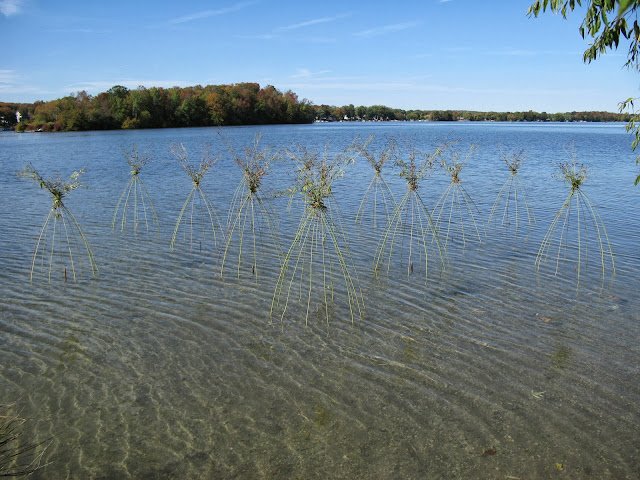A brief history of nature-based art
Nature-based art curriculum
Part 1:
WHAT IS ART?
Solicit definitions from assembled classes.
Share this definition......
"Art is anything created by anybody that somebody calls 'art'."
Sooooo....
WHAT IS NATURE-BASED ART?
"Art is anything created by anybody (using objects found in nature) that somebody calls 'art'.....
So .....
Is Stonehenge nature-based art?
How about 30,000 year cave paintings?
No. Art must be made by humans (or the machines they have created!)
Part 2:
(a by no means comprehensive survey of artists creating in this genre)
Also known as earth art or land art or even earthworks, for larger scale artworks, land-based, nature-based art is an American born, worldwide genre of art.
Originally a branch of conceptual art and minimalism, it really hit its stride in the late 1960s with artists such as Michael Heizer, Richard Long and Robert Smithson:
Michael Heizer is an American land artist specializing in large-scale and site-specific sculptures. Working largely outside the confines of the traditional art spaces of galleries and museums, Heizer has redefined sculpture in terms of size, mass, gesture, and process. A pioneer of 20th-century land art or Earthworks movement, he is widely recognized for sculptures and environmental structures made with earth-moving equipment, which he began creating in the American West in 1967. He currently lives and works in Hiko, Nevada, and New York City.
Double Negative is a piece of land art located in the Moapa Valley on Mormon Mesa (or Virgin River Mesa) near Overton, Nevada. Double Negative was created in 1969 by artist Michael Heizer, and consists of a trench dug into the earth.
Several of Long's works were based around walks that he has been taking since the mid 1960s where he has walked in places such as the Sahara Desert, Australia, Iceland and near his home in Bristol, United Kingdom. His work has proven to be revolutionary as it has changed how society views sculpture. His work has influenced the boundaries of sculpture to not be limited to only "traditional" materials and to be able to use alternative materials in his work. Not only is he using alternative materials such as rock and earth, but he also changed what art is, as the actual art piece can be the process of creating the art itself.[6]
In his work, often cited as a response to the environments he walked in, the landscape would be deliberately changed in some way, as in A Line Made by Walking (1967) (below), and sometimes sculptures were made in the landscape from rocks or similar found materials and then photographed. Other pieces consist of photographs or maps of unaltered landscapes accompanied by texts detailing the location and time of the walk it indicates.
Walter Joseph De Maria was an American artist, sculptor, illustrator and composer, who lived and worked in New York City. Walter de Maria's artistic practice is connected with minimal art, conceptual art, and land art of the 1960s.
The Lightning Field (1977 - below) is a land art work in Catron County, New Mexico, by sculptor Walter De Maria. It consists of 400 stainless steel poles with solid, pointed tips, arranged in a rectangular 1 mile × 1 kilometre grid array. While the work's title, form and best-known photographs may suggest the installation attracts lightning strikes, in fact these happen rarely
How about a wheat field?
Agnes Denes is a Hungarian-born American conceptual artist based in New York. She is known for works in a wide range of media—from poetry and philosophical writings to extremely detailed drawings, sculptures, and iconic land art works, such as Wheatfield — A Confrontation (1982), a two-acre field of wheat in downtown Manhattan grown on an empty field in the shadow of the World Trade Center.
Probably the best known contemporary nature-based artist, Andy Goldsworthy is an English sculptor, photographer, and environmentalist who produces site-specific sculptures and land art situated in natural and urban settings.
Portia Munson is an American visual artist who works in sculpture, installation, painting and digital photography, focusing on themes related to the environment and feminism. Her work includes large-scale agglomerations of mass-produced plastic found objects arranged by color, as well as small oil paintings of individual domestic found objects, and digital photographs of flowers, weeds and dead animals found near her home in upstate New York.
Norm Magnusson is a New York-based artist and political activist and founder, in 1991, of the art movement funism; he began his career creating allegorical animal paintings with pointed social commentaries. Eventually became more and more interested in political art and its potential for persuasion. His "Decorating Nature" series (examples below) consists of over 200 "interventions with nature", most with watercolor paint.
Twelve large blocks of ice cast off from the Greenland ice sheet are harvested from a fjord outside Nuuk and presented in a clock formation in a prominent public place. The work by Olafur Eliasson and Minik Rosing raises awareness of climate change by providing a direct and tangible experience of the reality of melting arctic ice. Ice Watch has been installed in three locations.
Michael McGillis is an American installation artist whose work focuses on the chaotic intersection of nature and human culture. He has created installation projects in public settings in the US, Europe, and Taiwan.
Imke Rust’s art explores the relationship between humans and nature. She provides alternative ways of seeing and understanding the world and our role in it. Her multi-layered works effortlessly combine and navigate between the personal, social, political and universal. Embracing a variety of media, such as drawing, installations, video and sculpture – the work of Imke Rust often uses and combines simple, everyday or found devices such as thorns, masking tape, salt or chalk. Rust regards materials and working processes as important carriers of the underlying message of the work and therefore carefully selects them to emphasize and add to specific aspects.
Lucy is a multidisciplinary artist specializing in digital media and emerging technologies, she explores cultural phenomena of the present day and its influence over society. Lucy aims to expose current issues through her desire to tap into non-human life. The digital craft is an essential part of her visual communication and she believes in life long digital learning.
sion and diversity.
James Brunt is an English artist who creates beautiful land art using natural objects in his home county, Yorkshire. The artist’s works will leave you with a feeling of serenity and calmness and after seeing them, you’ll want to try your hand at it yourself.
James uses stones, leaves, seashells and other natural objects he finds to arrange them into mesmerizing patterns and mandalas.
A creator of various styles of Land Art, his work is ephemeral in many differing ways; Most often the weather and immediate climate will make his work disappear (be blown down/washed away by the tide), and sometimes other people will interfere. Most of his work takes place in an already beautiful setting such as the Pembrokeshire coastline. Having grown up there he saw the beauty of the coastline and woodlands and made use of them by collaborating with nature itself.
Kristen Meyer is a multimedia artist based in New Haven, CT. Equally inspired by nature and modern architecture, her work harmonizes natural organic fluidity with mechanical like structure. In her art, she hopes to inspire others to find beauty in the seemingly ordinary.
Alejandro Durán is a multimedia artist whose practice utilizes photography and installation to examine the fraught intersections of humans and nature, revealing the pervasive impact of consumer culture on the natural world. His current work serves to mirror the reality of our current environmental predicament through a surreal aesthetic approach. The resulting photographs depict a new form of colonization by consumerism, where even undeveloped land is not safe from the far-reaching impact of our culture of disposable products.
Hungarian artist Krisztián Balogh created a sculpture called World Tree that’s carved directly into the ground. Created like a network of tree branches, the sculpture is 32 feet across and flows with water, making it seem like a living entity.
In 2012, Heizer completed Levitated Mass (2012). On permanent installation at Los Angeles County Museum of Art, Levitated Mass is a massive white, diorite boulder (21.5 feet wide and 21.5 feet high) that sits atop a 456-foot-long sloped walkway, allowing viewers to experience the weight of the rock as they walk through the empty space below. It took eleven nights, from February 28 to March 10, 2012, to move the 340-ton rock from Jurupa Valley to the museum. The installation is situated in a field of polished concrete slices, set at a slight angle between the Resnick Pavilion and Sixth Stree
"The Wakefield is comprised of seven rows of undulating rolling waves of earth and grass. The waves range in height from 10-15 feet, with a trough to trough distance of approximately 40 feet. The work at Storm King is the largest site specific art installation that Lin has created, and it marks a culmination in Lin’s series dedicated to the exploration of water wave formations that are translated into large scale, site specific earth works. Because it is executed in the same scale as an actual set of waves, the viewer’s experiences is similar that of being at sea, where one loses visual contact with adjacent waves. The curvature in plan and in section creates a compound curve that allows for a complex and subtle reading of the space— in the form of an environment that pulls the viewer in to its interior and allows for a sense of total immersion.
The site Lin selected is an environmental reclamation project, in compliance with The New York State Department of Environmental Conservation. The Storm King project involves the reclamation of a former gravel pit. For this project, Lin worked with landscape designer Edwina von Gal and horticulturist Darrel Morrison to create a low impact grass planting scheme.
Simon Beck is a British snow artist and a former cartographer. Referred to as the world's first snow artist, he is primarily known for his landscape drawings and sculptures created from snow and sand. His work appeared in new media after he completed installations at Banff National Park in Alberta and Powder Mountain, Utah. He later participated in Minnesota's annual snow festival, "The Great Northern".
Tanya Marcuse is a photographer whose recent work investigates the natural world in immersive, large scale photographs. These obsessively detailed photographs, each the product of weeks of collection and composition, are perched between the natural and the fantastic, evoking a Boschian world of allegory and fable.
Saman Oskouei and Sasan Oskouei are multidisciplinary artist-activists and brothers from Tabriz, Iran, currently located in Brooklyn, New York. The brothers collaboratively create nuanced political work, known for its simplicity yet resiliency and positive undertone. They address humanitarian topics such as borders and refugees, capitalism and inequalities, women's rights, and environmental issues.
Andres Amador is an American artist, known for his large-scale organic sand drawings.
Roy Frank Staab is an second-generation Earthworks artist, and Staab's photographic documentations attest to the site- and time-sensitive environmental works that he has executed in various ecosystems. Staab's ephemeral sculptures are constructed from natural materials such as reeds, willow shoots and bamboo.
German artist Walter Mason offers an interesting perspective on the natural world surrounding him. He examines relationships between natural elements, re-arranging and pulling them apart to put them back in new positions. The results are profound time-based-art sculptures that highlight the fragility and beauty of the environment. His careful geometric positioning of objects in space create surreal scenes that highlight the simultaneous complexity & simplicity that can often be found in nature.
Nils-Udo is a German artist from Bavaria who has been creating environmental art since the 1960s when he moved away from painting and the studio and began to work with, and in, nature. He began in the 1960s as a painter on traditional surfaces, in Paris, but moved to his home country in Bavaria and started to plant creations, putting them in Nature's hands to develop, and eventually disappear. In revealing the diversity in a specific environment, he establishes links between human and natural history, between nature and humanity that are always there, yet seldom recognized. Nils-Udo uses natural materials, such as sticks, petals, branches, to create site-specific installations.
Part 3: Let's go make some nature-based art!!




















































































































































Comments
Post a Comment